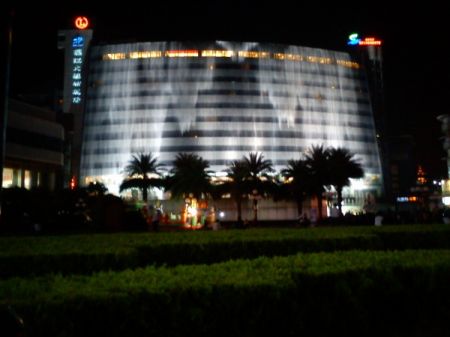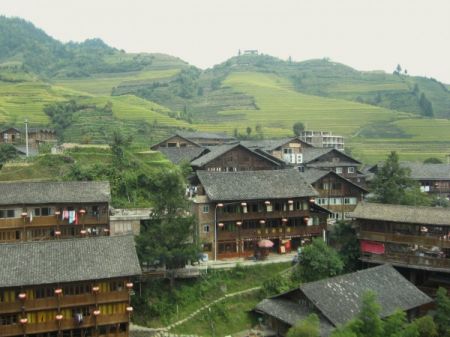You and I must have experienced writing about our school holiday trips during school days and the teachers used to reward us with applause or maybe a star. Once we grow up, we seldom get to express or share our feelings, thrill and excitement about our vacation trips and get rewarded in the same manner unless you are a freelance travel writer. For this article, all I can say is that it all started with an opportunistic friend of mine who had kindly offered to lend me a travel guide book upon knowing my travel plan to China. It only transpired later that it is subject to a condition which is the very reason of existence of this article. I suspect the book is greatly possessed with the ability to hypnotize its reader to carry out the malice intention of its owner.
My sister, her friend and I set sail to begin our adventurous journey to Guilin of China on an early foggy Saturday morning. The city’s name means “forest of sweet osmanthus” (“gui” means “osmanthus tree” while “lin” means “forest“.) It was indeed adventurous even from the beginning as we were confined to the plane for 7 hours when we should have reached in 4 hours. 1 ½ hours after the flight took off, we received an unexpected announcement from the flight captain that due to some technical problems and safety compliance issue, the flight has to return to LCCT airport where all the passengers are required to get down and board another plane. We could only feel relieve that it wasn’t until ½ hour before reaching the destination that the problems were discovered. The moment the flight landed back on LCCT, I watched amusingly the old lady sitting next to me who had been asleep throughout the flight woke up with puffy eyes and uttered in Mandarin “Wah, not bad, we reach so fast!”.
We landed in early evening to greet the great scent of the forest of sweet osmantus. At night, we celebrated our safe arrival at a town square in the downtown area of Guilin city. The night life of the city was catalysed by senses stimulating vibrant Chinese cultural performances at the square like classical fan dance, folk dance, stage show and group singing. The visual effect of the performances was further enhanced by the colorful costumes worn by the dancers. Fan dance, believed to have begun during the Han dynasty is always one of my favourite traditional performances as it captures the highest level of the beauty of Chinese culture; the delicate, dynamic and graceful movements of performers. At the same time it allows the dancers to communicate her feelings, emotions and intentions with mere expression and without words.

Right opposite the square stood the infamous Guilin Lijiang Waterfall Hotel. At 8.30 p.m. sharp , with the soft breeze caressing our faces, we witnessed the artificial waterfall, listed in the Guiness Book of Records, rushes splendidly down from the hotel roof top. This short waterfall display of 15 minutes was one of the main attractions of the nightlife in the city and you didn’t have to be the hotel guest to enjoy it.

We then walked around the lake nearby and saw many illuminated bridges, pagoda and street performances. I was longing to see some portrait painters and sketches on the street but I wasn’t lucky enough. However, what caught my attention instead was a band of young street artists playing guitar and singing familiar Cantonese oldies songs just for fun. The music power was almost magical it made me hummed along.
The next day early in the morning, from Guilin city we traversed further to LongJi (Dragon’s Backbone) Terraced Field at LongSheng by bus and van. The journey took us about 3 hours with plenty of retreat from the road side which offered us beautiful countryside scenery. The LongJi Terraced Field received its name because the rice terraces resemble a dragon’s scales, while the summit of the mountain range looks like the backbone of the dragon. By the time we reached the foot of the mountain, it was almost noon. Clothed with the color of the fall, the view of the terraced field was simply breathtaking. Large scaled rice terraces were seen built along the hillsides with many small villages scattered across the mountains. These farming villages were occupied by the minority Zhuang and Yao ethnic tribes of China. They were collectively called Ping An (Peaceful) Village. Coincidentally, the village would be holding its 2nd term of its annual election of the village representatives. Lists of voters above 18 were seen pasted at the entrance counter of the village. It was fascinating to watch layers and layers of terraced field wind up from the foot to the summit of the mountain along the slopes. Rice stalks ripe enough to be harvested were billowing in the breeze as if they were welcoming us.

Having a weak stamina and acrophobia, hiking would always be the last activity I would take part in as it is an uphill task for me. Nonetheless, as we had decided to stay overnight at the mountain, we started to climb up along the mountain paths to get to our bamboo-made chalet located not too far from the bottom of the mountain. Along the way, some tourists were seen traveling up the mountain paths in sedan chairs. However, what was more inspiring were the figures of a group of busy and hardworking people walking ahead of us. These people were not busy climbing the mountain, selling handicraft or taking photographs. Instead, stooped like rice stalks, this was a group of elderly local men and women in their well-preserved colorful traditional clothes offering to carry tourists’ bags in the bamboo baskets attached to their backs. With not much smile on their face, the sweat fell down from their head scarf down the sides of their wrinkled cheeks. Be it to earn for a living or just to kill time, they earned my respect and motivated me to continue climb up the mountain.

After checking in the chalet, we proceeded to explore this colorful cultural relic of minority tribes. Wandering on foot, we observed the living life style, primitive way of preparation of food like bamboo chicken and the culture of these ethnic minorities. The houses there were all uniquely made of bamboo and wood. If there is one drawback of the village, it is that the place was slightly commercialized and packed with tourists everywhere.
Once in a while, we had to walk cautiously to the inner trail to avoid the goods carrying horses led by the villagers. As we climbed up the mountain paths, each view that opened up was more beautiful than the one before. This magnificent wave-like terraced field not only gives a lot of momentum to the tourists but it also has a few fabulous viewpoints offering a photography paradise to passionate photographers. With some regrets, and believing that hiking was never a race with others, I succumbed to the height of the mountain half way along the climbing. Nevertheless, at that viewpoint, no matter how much effort it took, it was all worthwhile.


As the night fell, it became chillier at this mountainous area. We rested early knowing that something awaited us the next day.

